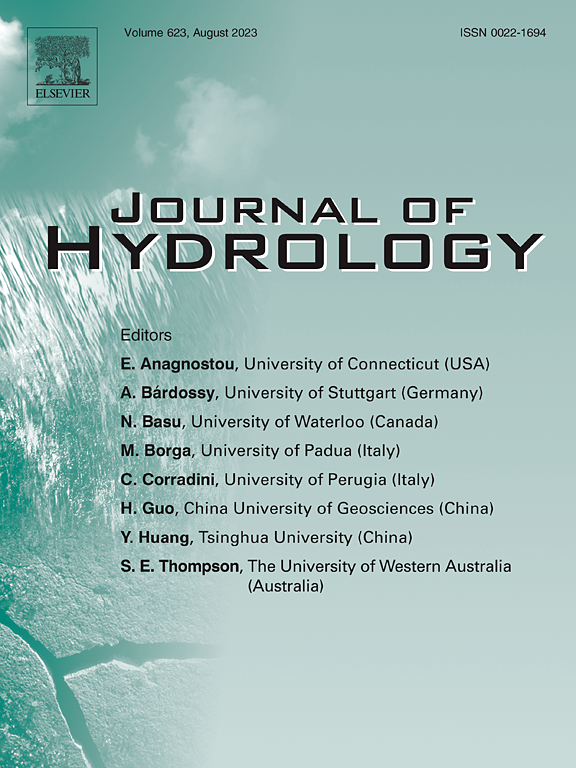美国加利福尼亚州San Ardo油田地下水TDS的地球化学、地球物理和温度联合高斯过程模型
IF 5.9
1区 地球科学
Q1 ENGINEERING, CIVIL
引用次数: 0
摘要
新鲜地下水供应的减少扩大了人们对微咸地下水资源的兴趣;然而,人们对微咸地下水的分布知之甚少。美国各地沉积盆地的水资源往往凌驾于油气开发之上。利用油井地球物理测井资料进行地下水总溶解固体(TDS)作图已成为识别淡水和微咸地下水的重要技术。现有的地球物理测井分析方法利用孔隙度和温度将地层电阻率与TDS联系起来。通常,利用天然地温梯度来估计所采集电阻率位置的温度。然而,在热强化油田中,将蒸汽注入地下以调动高粘度油,从而产生可变的温度分布。此外,由电阻率得出的TDS也取决于优势离子的分数。通常,必须测定氯化物和碳酸氢盐的分数。还需要对具有非均质孔隙度分布的许多地质单元的TDS进行建模。总的来说,用于估计TDS的每个量(电阻率、孔隙度、温度、碳酸氢盐含量)在空间和时间上都是不同的,而且可用的数据点很少重合。在这里,我们提出了一种新的地下水TDS制图方法,该方法将每个量与联合高斯过程一起连续建模。这种方法可以用实际可用的数据绘制淡水和半咸淡水。我们将这种方法应用于加利福尼亚州蒙特雷县的San Ardo油田,该油田发生了蒸汽注入。在油带上的含水层系统的一些区域,温度为~ 75°C,大约是自然背景值的两倍。地下水TDS在含水层中通常为1,500 mg/L,在产油区随深度增加至约9,000 mg/L。低渗透粘土层将淡水和微咸水圈定,可能是通过抑制地表回灌渗入深层,从而使tds较高的原生水得以保留。较弱的侧向TDS趋势可能受到与萨利纳斯河有关的补给模式的控制。我们的模型非常肯定地表明,在产油区的一个局部地区,地下水已经变新鲜,但不太确定的是,更广泛的变新鲜也发生了。TDS的降低可能是由于数十年的低TDS注蒸汽以及相关的流体生产和处置作业。本文章由计算机程序翻译,如有差异,请以英文原文为准。
A joint Gaussian process model of geochemistry, geophysics, and temperature for groundwater TDS in the San Ardo Oil Field, California, USA
Decline in availability of fresh groundwater has expanded interest in brackish groundwater resources; however, the distribution of brackish groundwater is poorly understood. Water resources in sedimentary basins across the United States often overlie oil and gas development. Mapping of groundwater total dissolved solids (TDS) using data from oil well geophysical logs has become an important technique for identifying fresh and brackish groundwater.
Existing geophysical log analysis methods use porosity and temperature to relate formation resistivity to TDS. Typically, natural geothermal gradients are used to estimate temperature at the location of collected resistivity. However, in thermally enhanced oil fields, steam is injected into the subsurface to mobilize high viscosity oil, creating variable temperature distributions. Furthermore, TDS derived from resistivity also depends on the fractions of dominant ions. Typically, chloride and bicarbonate fractions must be determined. It is also necessary to model TDS across many geologic units with heterogenous porosity distributions. Collectively, each quantity used to estimate TDS (resistivity, porosity, temperature, bicarbonate fraction) varies in space and time, and available data points are rarely collocated.
Here, we present a new method of mapping groundwater TDS that continuously models each quantity together with a joint Gaussian process. This method enables mapping fresh and brackish water with practically available data. We apply this method to the San Ardo Oil Field in Monterey County, California, where steam injection occurs. In some areas of the aquifer system overlying the oil zone, the temperature is ∼75 °C, roughly twice the natural background value. Groundwater TDS is typically <1,500 mg/L in the aquifer and increases with depth to ∼9,000 mg/L in the oil-producing zone. A low-permeability clay layer delineates the fresh and brackish water, likely by inhibiting surface recharge from penetrating the deeper zones, allowing higher-TDS connate water to remain in place. Weaker lateral TDS trends may be controlled by recharge patterns associated with the Salinas River. Our model reveals with high certainty that groundwater has freshened in one localized part of the oil-producing zone and suggests with less certainty that more widespread freshening has also occurred. The lowering of TDS was possibly from decades of low-TDS steam injection and the associated fluid production and disposal operations.
求助全文
通过发布文献求助,成功后即可免费获取论文全文。
去求助
来源期刊

Journal of Hydrology
地学-地球科学综合
CiteScore
11.00
自引率
12.50%
发文量
1309
审稿时长
7.5 months
期刊介绍:
The Journal of Hydrology publishes original research papers and comprehensive reviews in all the subfields of the hydrological sciences including water based management and policy issues that impact on economics and society. These comprise, but are not limited to the physical, chemical, biogeochemical, stochastic and systems aspects of surface and groundwater hydrology, hydrometeorology and hydrogeology. Relevant topics incorporating the insights and methodologies of disciplines such as climatology, water resource systems, hydraulics, agrohydrology, geomorphology, soil science, instrumentation and remote sensing, civil and environmental engineering are included. Social science perspectives on hydrological problems such as resource and ecological economics, environmental sociology, psychology and behavioural science, management and policy analysis are also invited. Multi-and interdisciplinary analyses of hydrological problems are within scope. The science published in the Journal of Hydrology is relevant to catchment scales rather than exclusively to a local scale or site.
 求助内容:
求助内容: 应助结果提醒方式:
应助结果提醒方式:


